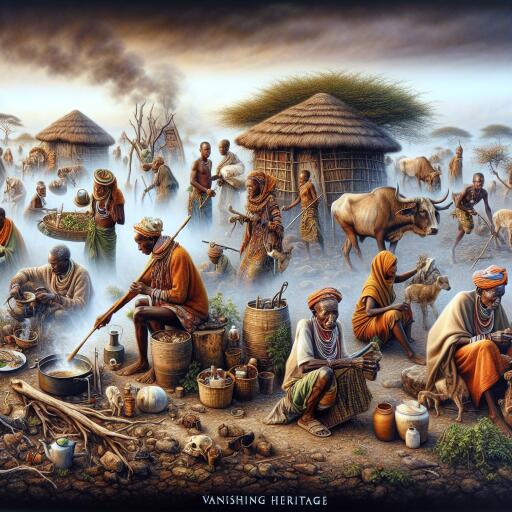
Vanishing Heritage: Tanzania’s Hadzabe and Tatoga Face Climate Change Threats
Tanzania, known for its rich cultural mosaic of over 120 ethnic groups, is witnessing a stark reality—the gradual disappearance of two of its most distinctive communities, the Hadzabe and Tatoga. As climate change, land encroachment, and socio-economic challenges escalate, the traditional lifestyles of these groups are under existential threat.
The Hadzabe, one of the last remaining hunter-gatherer communities worldwide, primarily inhabit the Yaeda Valley near Lake Eyasi. Despite their numbers being a mere 1,300 to 1,500, they have sustained themselves in harmony with nature for centuries. However, their resilience is increasingly challenged today.
In 2023, climate-induced disasters like flash floods and mudslides in the Babati and Mbulu districts severely impacted their habitat. It is reported that nearly 60 percent of Hadzabe dwellings suffered, pushing many to find refuge elsewhere. “Their survival is inseparable from their environment; when it is distressed, so are they,” expresses a governance and economic policy expert.
Similarly, the Tatoga community faces parallel threats. Predominantly pastoralists distributed across the Manyara, Singida, and Dodoma regions, their survival largely revolves around livestock. Persistent droughts, however, have diminished grazing lands, thrusting them into competition for resources with other groups.
The future looks precarious for these communities due to rising temperatures, erratic rainfall, biodiversity loss, and water scarcity. For the Hadzabe, who depend on wild plants and game, the dwindling of these resources poses a direct threat to their existence. It is estimated that only 150 to 200 Hadzabe still adhere to traditional hunting and gathering, as displacement forces them to drift from their ancestral practices.
The Tatoga, also referred to as Wadatooga, Wataturu, or Wamang’ati, contend with reduced grazing lands due to urban sprawl and commercial agriculture. Many have resorted to migration or unsustainable practices, leading to marginalisation in urban settings.
The Importance of Protecting Indigenous Communities
Indigenous groups like the Hadzabe and Tatoga are indispensable guardians of biodiversity. A United Nations estimate underscores that although indigenous peoples constitute less than 5 percent of the global population, they protect over 80 percent of the world’s biodiversity.
Their traditional wisdom and sustainable practices are crucial in preserving ecosystems and addressing climate change. “Recognising indigenous rights often correlates with reduced deforestation rates and increased carbon stocks,” an expert remarks.
The Hadzabe’s profound knowledge of the local flora and fauna has nurtured conservation in the Yaeda Valley. Similarly, the Tatoga’s pastoral practices, when bolstered with sustainable resources, contribute to the region’s ecological balance. Yet, these crucial contributions often go unacknowledged, receiving minimal customised support from either the government or international organisations.
Tanzania’s policies frequently overlook these groups’ unique vulnerabilities, a shortcoming that experts believe hinders comprehensive climate governance. “It’s vital for the government to develop policies that cater specifically to indigenous needs,” advocates an environmental policy researcher. “Securing land rights, ensuring access to education and healthcare, and appreciating their knowledge within national conservation strategies are imperative steps.”
Global findings suggest that securing indigenous rights can improve ecosystem health and curb deforestation. Local collaboration among authorities, non-governmental organisations, and international bodies could encourage reforestation, water conservation, and climate-resilient agricultural practices to secure these communities’ futures.
“If immediate actions aren’t taken, we might lose these communities within decades,” a researcher warns. “The loss extends beyond the communities themselves—it’s a loss for Tanzania and mankind.”
Conservation Efforts and Future Actions
Acknowledging the urgency, Tanzania has implemented measures to preserve its cultural and natural legacy. The Hadzabe and Tatoga are officially recognised as indigenous groups with explicit rights to their ancestral lands, including the Yaeda Valley. These protective actions intend to conserve their cultural practices and traditional insights.
The emergence of cultural tourism initiatives in regions like Lake Eyasi affirms indigenous customs while offering economic motives for conservation. Additionally, Tanzania’s collaboration with UNESCO aims to safeguard its diverse cultural and natural heritage, encompassing indigenous languages and traditions.
However, even with these measures, experts insist that more decisive steps are required. “The challenges faced by the Hadzabe and Tatoga highlight the urgent need for inclusive climate policies and concerted efforts to preserve their heritage,” notes an expert. Their endurance signifies more than cultural preservation; it reflects Tanzania’s commitment to biodiversity and climate justice.
Safeguarding these ‘endangered’ communities is pivotal for fostering a sustainable future, a responsibility Tanzania cannot afford to neglect.





Leave a Reply